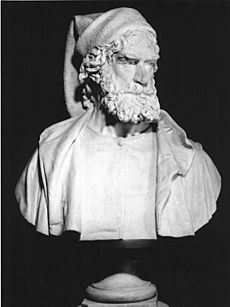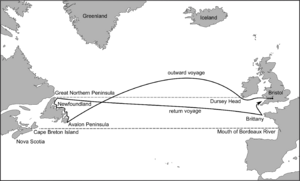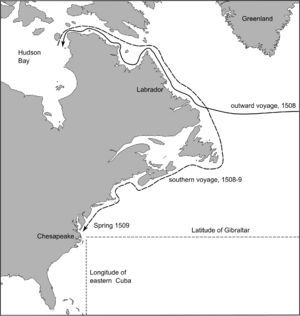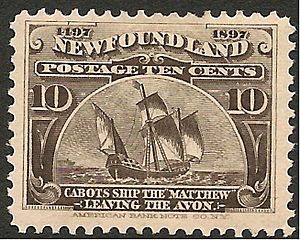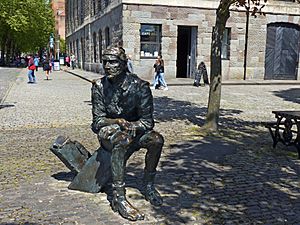John Cabot facts for kids
Quick facts for kids
John Cabot
|
|
|---|---|
| Giovanni Caboto | |

John Cabot in traditional Venetian garb by Giustino Menescardi (1762) – a mural painting in the Sala dello Scudo in the Palazzo Ducale, Venice
|
|
| Born | c. 1450 Gaeta, Kingdom of Naples or Castiglione Chiavarese, Republic of Genoa (disputed)
|
| Died | Between c. 1498 and 1501 |
| Nationality | Italian |
| Other names | Giovanni Caboto, Zuan Chabotto, Giovanni Chabotte, Juan Caboto, Jean Caboto |
| Occupation | Maritime explorer |
| Known for | First European since the Norse colonization of North America to explore coastal parts of North America |
| Spouse(s) | Mattea (m. circa 1470) |
| Children | Ludovico, Sebastian, and Sancto |
John Cabot (Italian: Giovanni Caboto c. 1450 – c. 1500) was an Italian explorer. His 1497 voyage to the coast of North America is the earliest known European exploration of coastal North America since the Norse visits to Vinland in the eleventh century.
Contents
Early life and career
Cabot was born in Italy, the son of Giulio Caboto and his wife. He had a brother Piero. Gaeta (in the Province of Latina) and Castiglione Chiavarese (in the Province of Genoa) have both been proposed as birthplaces.
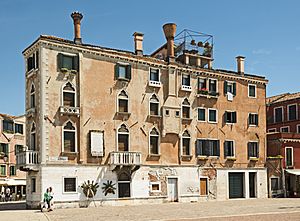
In 1476 Cabot was made a citizen of the Republic of Venice, which required a minimum of fifteen years' residency in the city; thus he must have lived in Venice since at least 1461.
Once he gained Venetian citizenship, Cabot would have been eligible to engage in maritime trade, including the trade to the eastern Mediterranean that was the source of much of Venice's wealth. He presumably entered this trade shortly thereafter.
Cabot appears to have gotten into financial trouble in the late 1480s and left Venice as an insolvent debtor by 5 November 1488. He moved to Valencia, Spain. Early in 1494 he moved on to Seville, where he proposed, was contracted to build and, for five months, worked on the construction of a stone bridge over the Guadalquivir river. This project was abandoned following a decision of the City Council on 24 December 1494. After this Cabot appears to have sought support in Seville and Lisbon for an Atlantic expedition, before moving to London to seek funding and political support. He probably reached England in mid-1495.
Henry VII
On arrival in England, Cabot went to Bristol, a major maritime centre, to seek financial backers. On 5 March 1496 Henry VII gave Cabot and his three sons letters patent with the following charge for exploration:
... free authority, faculty and power to sail to all parts, regions, and coasts of the eastern, western and northern sea, under our banners, flags, and ensigns, with five ships or vessels of whatsoever burden and quality they may be, and with so many and with such mariners and men as they may wish to take with them in the said ships, at their own proper costs and charges, to find, discover and investigate whatsoever islands, countries, regions or provinces of heathens and infidels, in whatsoever part of the world placed, which before this time were unknown to all Christians.
Those who received such patents had the right to assign them to third parties for execution. His sons are believed to have still been minors at that time.
Expeditions
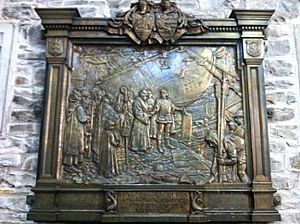
First voyage
Little is known of Cabot's first voyage. What is known as the "John Day letter", written by John Day, alias Hugh Say, a Bristol merchant originally of London, was sent during the winter of 1497–98 to an addressee believed to be Christopher Columbus. The letter refers briefly to this voyage but writes mostly about the second, 1497 expedition. Day noted: "Since your Lordship wants information relating to the first voyage, here is what happened: he went with one ship, his crew confused him, he was short of supplies and ran into bad weather, and he decided to turn back." Since Cabot received his royal patent in March 1496, it is believed that he made his first voyage that summer.
Second voyage
The known sources do not concur on all aspects of the events, and can't be viewed as entirely reliable. Cabot was described as having one "little ship", of 50 tons' burden, called Matthew of Bristol (according to the 1565 chronicle). It was said to be laden with sufficient supplies for "seven or eight months". The ship departed in May with a crew of 18 to 20 men.
Leaving Bristol, the expedition sailed past Ireland and across the Atlantic, making landfall somewhere on the coast of North America on 24 June 1497. The exact location of the landfall has long been disputed, but most historians agree it was either Newfoundland or nearby Cape Breton Island.

For the 500th-anniversary celebrations, the governments of Canada and the United Kingdom designated Cape Bonavista in Newfoundland as the "official" landing place.
It is believed that Cabot landed only once during the expedition and made no contact with any native people; the crew found the remains of a fire, a human trail, nets, and a wooden tool. The crew appeared to have remained on land just long enough to take on fresh water; they also raised the Venetian and Papal banners, claiming the land for the King of England and recognising the religious authority of the Roman Catholic Church. After this landing, Cabot spent some weeks "discovering the coast", with most "discovered after turning back".
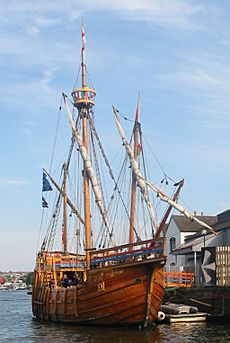
On return to Bristol, Cabot rode to London to report to the king. On 10 August 1497, he was given a reward of £10—equivalent to about two years' pay for an ordinary labourer or craftsman. Similar to Christopher Columbus, he was "called the Great Admiral", and vast honour was paid to him.
On 13 December 1497, the explorer was awarded a pension (or salary) of £20 per year. On 3 February 1498, Cabot was given new letters patent covering the voyage and to help him prepare another expedition.
Final voyage
At the beginning of May 1498, Cabot departed with a fleet of five ships from Bristol. Some of the ships were carrying merchandise, including cloth, caps, lace points, and other "trifles". This suggests that Cabot intended to engage in trade on this expedition. The Spanish envoy in London reported in July that one of the ships had been caught in a storm and been forced to land in Ireland, but that Cabot and the other four ships had continued on.
For centuries, no other records were found (or at least published) that relate to this expedition; it was long believed that Cabot and his fleet were lost at sea. But at least one of the men scheduled to accompany the expedition, Lancelot Thirkill, is recorded as living in London in 1501.
It is not known whether Cabot died during the voyage, returned safely and died shortly after, or arrived in the Americas and chose to remain there, perhaps remaining with the Indigenous people in a similar manner to Étienne Brûlé.
Family
Cabot married Mattea around 1470, and had issue including three sons:
- Ludovico Caboto
- Sebastiano Caboto
- Santo Caboto
Legacy and honors
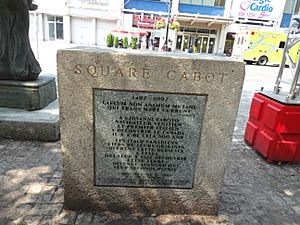
- Giovanni Caboto (1762), painting at Ducal Palace, Venice.
- Cabot Tower (1897) in St. John's, Newfoundland and Labrador, to commemorate the 400th anniversary of Cabot's voyage.
- Cabot Tower, in Bristol, England. A 30-metre-tall red sandstone tower begun in 1897 to mark the 400th anniversary.
- Denis William Eden painting: John Cabot and his sons receive the charter from Henry VII to sail in search of new lands (1910), at Houses of Parliament.
- Giovanni Caboto Club (est. 1925), an Italian club located in Windsor, Ontario.
- A 1952 statue of the explorer is at Bristol's City Hall.
- John Cabot University is a United States-affiliated university established in 1972 in Rome, Italy.
- A 1985 bronze statue of the explorer by Stephen Joyce, is located at Bristol Harbourside.
- A replica of the Matthew of Bristol built to commemorate the 500th anniversary of the 1497 voyage, docked in Bristol.
- A second replica of the Matthew is located at Cape Bonavista.
- The scenic Cabot Trail in the Cape Breton Highlands is named after the explorer.
- John Cabot Academy is an independent school in Bristol, England.
- Cabot Ward was an electoral district in Bristol (abolished in 2016), indirectly named for the explorer and directly after the local Cabot Tower.
- Cabot Squares in London and Montreal.
- Cabot Circus, a 2008 shopping mall in Bristol, named as a result of a citywide poll.
- Cabot Street and Cabot Avenue in St. John's, Newfoundland and Labrador.
- A bronze statue of the explorer stands at the Confederation Building, St. John's.
- A bronze statue of the explorer is located at Cape Bonavista, Newfoundland. Plaques in English, French and Italian commemorate the historic voyage.
- John Cabot Catholic Secondary School in Mississauga, Ontario, is named after the explorer.
- Giovanni Caboto park located in Edmonton, Alberta.
- The Cabot Institute for the Environment at the University of Bristol is named after him.
- In 1897, the Newfoundland Colony issued a postage stamp, and in 1947, the Dominion of Newfoundland issued a postage stamp, marking the 400th and 450th anniversaries of Cabot's voyage to that island, respectively.
Interesting facts about John Cabot
- Cabot is known today as Giovanni Caboto in Italian, Zuan Caboto in Venetian, Jean Cabot in French, and John Cabot in English. This resulted from a once-ubiquitous European tradition of nativizing names in local documents.
- He may have been born slightly earlier than 1450, which is the approximate date most commonly given for his birth.
- The historian Alwyn Ruddock worked on Cabot and his era for 35 years. She suggested that Cabot and his expedition successfully returned to England in the spring of 1500. She claimed their return followed an epic two-year exploration of the east coast of North America, south into the Chesapeake Bay area and perhaps as far as the Spanish territories in the Caribbean.
- Sebastian Cabot, one of John's sons, also became an explorer, later making at least one voyage to North America.
- The United States Navy named 2 ships USS Cabot, a 14-gun brig in 1775 and a light aircraft carrier in 1943.
See also
 In Spanish: Juan Caboto para niños
In Spanish: Juan Caboto para niños


